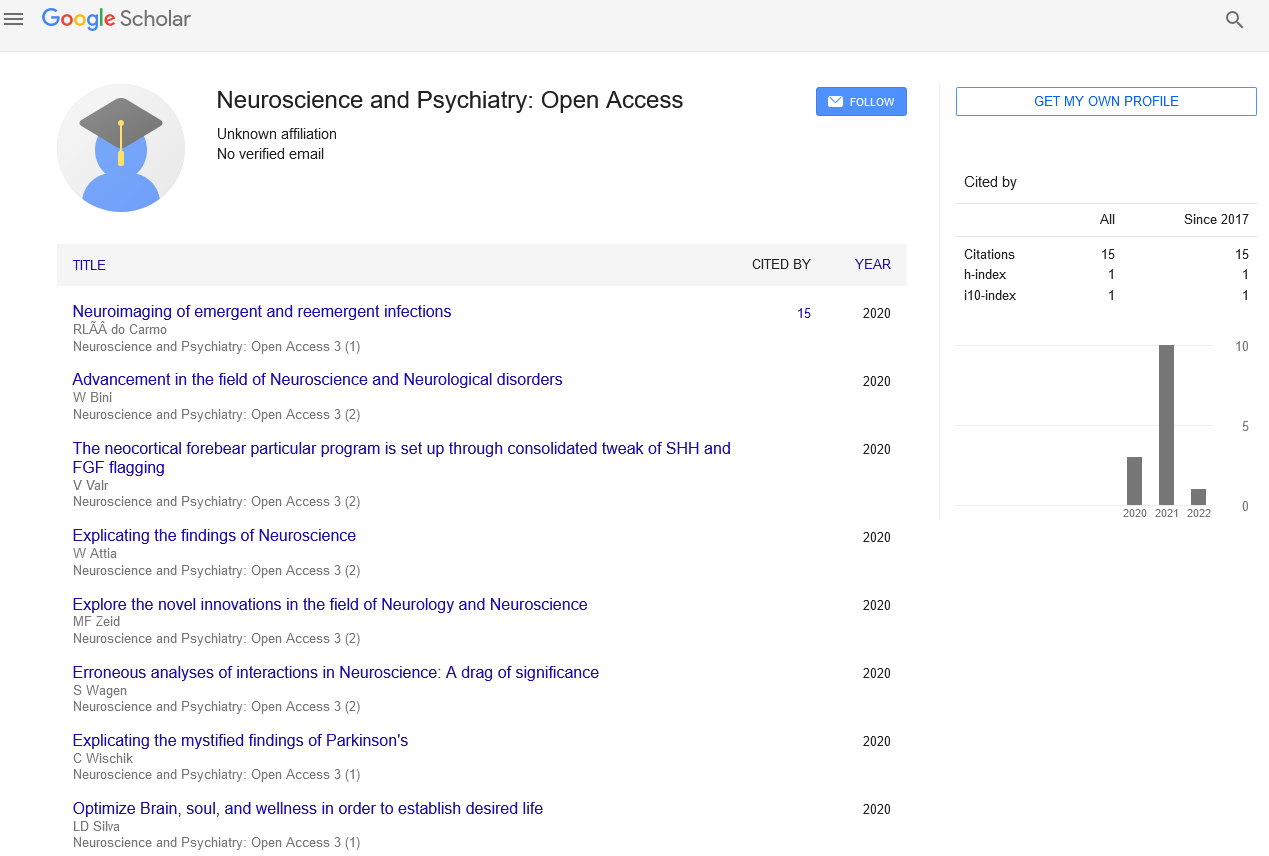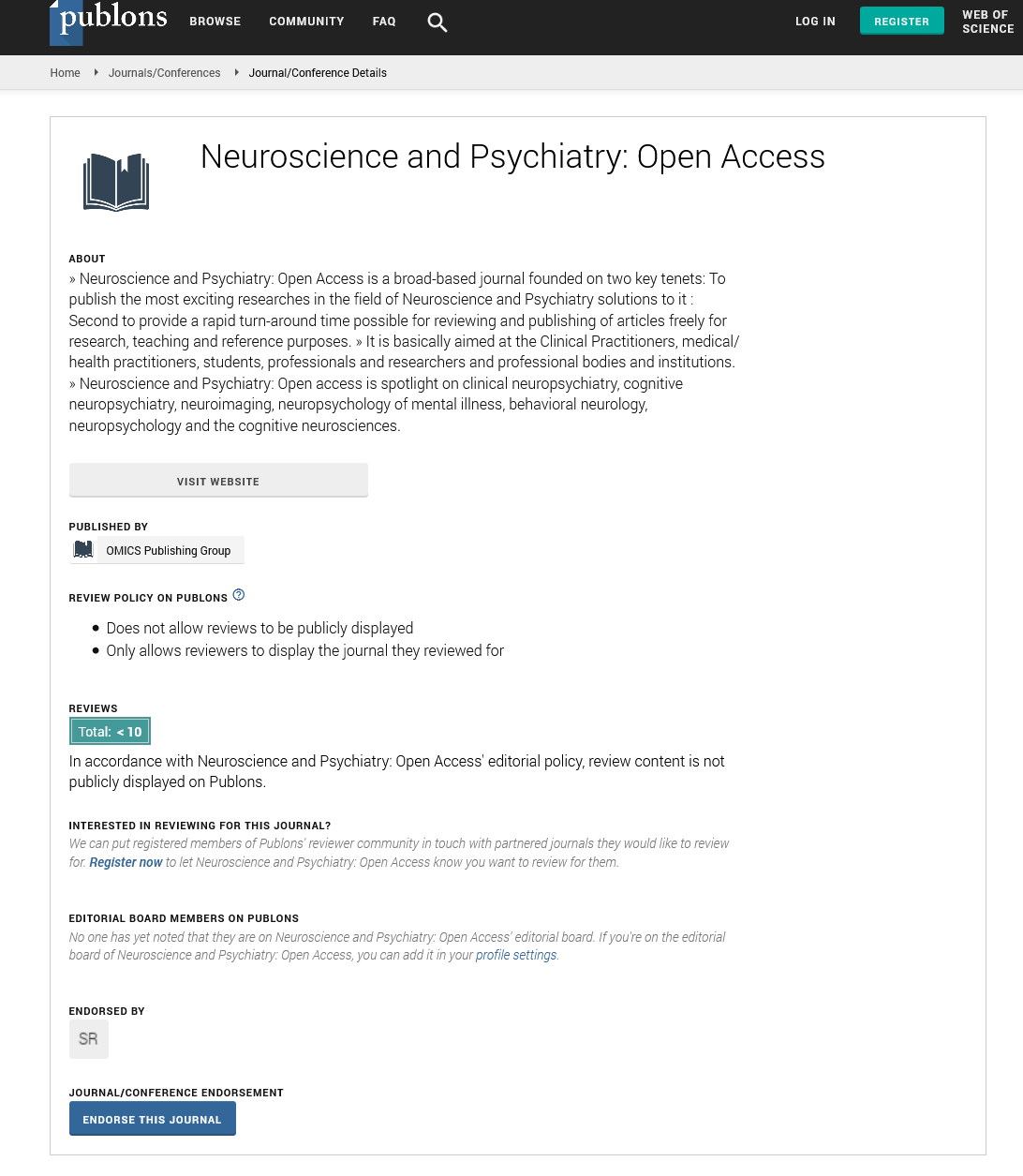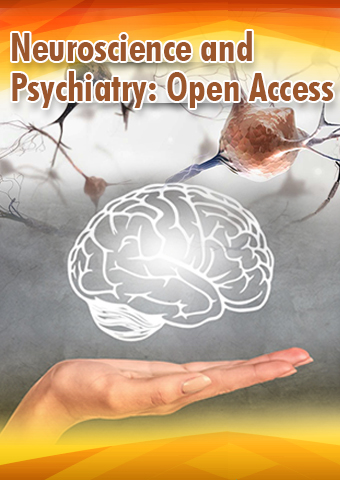Perspective - Neuroscience and Psychiatry: Open Access (2024) Volume 7, Issue 2
Unraveling the Mysteries of Neurodegeneration: Insights, Challenges, and Hope
- Corresponding Author:
- Inez Myin-Germeys
Department of Neurosurgery, Universitair Ziekenhuis Brussel, Brussels, Belgium
E-mail: inez.ger23@kuleuven.be
Received: 13-02-2024, Manuscript No. NPOA-24-128845; Editor assigned: 16-02-2024, PreQC No. NPOA-24-128845 (PQ); Reviewed: 01-03-2024, QC No. NPOA-24-128845; Revised: 12-03-2024, Manuscript No. NPOA-24-128845 (R); Published: 19-03-2024, DOI: 10.47532/npoa.2024.7(2).194-196
Introduction
Neurodegeneration, the progressive loss of structure and function of neurons in the central nervous system, stands as a formidable challenge to human health and well-being. From Alzheimer’s disease and Parkinson’s disease to Amyotrophic Lateral Sclerosis (ALS) and Huntington’s disease, neurodegenerative disorders exact a heavy toll on individuals, families, and society as a whole. Despite decades of research, the underlying mechanisms driving neurodegeneration remain elusive, impeding the development of effective treatments and interventions. In this article, we embark on a journey into the complex world of neurodegeneration, exploring its manifestations, mechanisms, and the quest for therapeutic breakthroughs.
Description
Understanding neurodegeneration
Neurodegeneration encompasses a diverse array of disorders characterized by the progressive dysfunction and death of neurons, leading to cognitive decline, motor impairment, and loss of independence. While each neurodegenerative disease presents with distinct clinical features and pathological hallmarks, common themes emerge regarding the mechanisms underlying neuronal demise.
• Protein misfolding and aggregation: Accumulation of misfolded proteins represents a hallmark feature of many neurodegenerative diseases. In Alzheimer’s disease, for instance, amyloid-beta peptides aggregate to form plaques, while hyperphosphorylated tau protein aggregates into neurofibrillary tangles, disrupting neuronal function and connectivity. Similarly, in Parkinson’s disease, alpha-synuclein aggregates into Lewy bodies, contributing to the loss of dopaminergic neurons in the substantia nigra.
• Mitochondrial dysfunction: Mitochondria, the cellular powerhouses responsible for energy production, play a critical role in neuronal survival and function. Dysfunction of mitochondria, characterized by impaired oxidative phosphorylation, increased production of Reactive Oxygen Species (ROS), and defective mitochondrial dynamics, has been implicated in various neurodegenerative disorders. Mitochondrial dysfunction compromises cellular energy metabolism, triggers oxidative stress, and exacerbates neuronal injury, ultimately contributing to neurodegeneration.
• Neuroinflammation: Activation of innate immune responses within the central nervous system, termed neuroinflammation, is a prominent feature of neurodegenerative diseases. Microglia, the resident immune cells of the brain, become activated in response to pathological insults and release pro-inflammatory cytokines, chemokines, and reactive oxygen species. While neuroinflammation initially serves a protective role by clearing debris and pathogens, chronic activation can exacerbate neuronal injury and contribute to disease progression.
• Excitotoxicity: Dysregulation of glutamatergic neurotransmission and excessive activation of glutamate receptors, particularly N-methyl-D-aspartate (NMDA) receptors, contribute to neuronal excitotoxicity in neurodegenerative diseases. Excessive glutamate release, impaired glutamate clearance, and alterations in receptor expression and function disrupt calcium homeostasis, activate downstream signaling cascades, and promote neuronal injury and death.
Challenges in neurodegenerative disease research
Despite significant advances in our understanding of neurodegeneration, numerous challenges persist in the quest to unravel its complexities and develop effective treatments.
• Disease heterogeneity: Neurodegenerative diseases exhibit substantial clinical and pathological heterogeneity, posing challenges for accurate diagnosis and classification. Within each disease category, patients may present with diverse symptom profiles, disease trajectories, and underlying molecular pathologies. This heterogeneity complicates clinical trial design and may contribute to variability in treatment response among patients.
• Limited biomarkers: Biomarkers play a crucial role in disease diagnosis, prognosis, and monitoring treatment response. However, the identification of reliable biomarkers for neurodegenerative diseases remains a major challenge. Current biomarkers lack sensitivity and specificity, often reflecting advanced disease stages rather than early pathological changes. The development of novel biomarkers capable of detecting preclinical disease stages and tracking disease progression is a critical unmet need in the field.
• Blood brain barrier: The blood-brain barrier, a highly selective membrane that regulates the exchange of molecules between the bloodstream and the brain, poses a formidable obstacle to drug delivery for neurodegenerative diseases. Many potential therapeutic agents exhibit poor blood-brain barrier permeability, limiting their efficacy in targeting pathological processes within the central nervous system. Strategies to overcome this barrier, such as the development of blood brain barrier penetrating drugs or targeted delivery systems, hold promise for enhancing the effectiveness of neuroprotective interventions.
• Therapeutic resistance: Despite promising preclinical results, many potential neuroprotective agents have failed to demonstrate efficacy in clinical trials for neurodegenerative diseases. Therapeutic resistance may arise from various factors, including inadequate target engagement, suboptimal drug dosing or timing, and compensatory mechanisms within the diseased brain. Overcoming therapeutic resistance will require a deeper understanding of the molecular mechanisms driving neurodegeneration and the development of innovative therapeutic strategies targeting multiple pathways implicated in disease pathogenesis.
Hope on the horizon
While the challenges of neurodegenerative disease research are formidable, there is reason for cautious optimism on the horizon.
• Precision medicine approaches: Advances in genomics, proteomics, and other omics technologies hold promise for advancing precision medicine approaches in neurodegenerative diseases. By integrating clinical and molecular data, researchers can identify disease subtypes, predict disease progression, and stratify patients based on their molecular profiles. Precision medicine approaches enable personalized treatment strategies tailored to the individual characteristics of each patient, maximizing therapeutic efficacy and minimizing adverse effects.
• Disease modifying therapies: Traditional symptomatic treatments for neurodegenerative diseases provide temporary relief of symptoms but do not alter the underlying disease course. The development of disease modifying therapies capable of slowing or halting disease progression represents a major goal in the field. Strategies targeting key pathological mechanisms, such as protein aggregation, mitochondrial dysfunction, neuroinflammation, and excitotoxicity, offer potential avenues for developing diseasemodifying treatments that address the root causes of neurodegeneration.
• Multimodal interventions: Given the multifactorial nature of neurodegenerative diseases, multimodal interventions targeting multiple pathological pathways simultaneously may offer greater therapeutic benefit than single-target approaches. Combination therapies that synergistically target protein misfolding, mitochondrial dysfunction, neuroinflammation, and excitotoxicity hold promise for enhancing neuroprotection and preserving neuronal function in affected individuals. Moreover, non-pharmacological interventions, such as lifestyle modifications, physical exercise, cognitive training, and social engagement, may complement pharmacological treatments and promote brain health and resilience.
Conclusion
Neurodegeneration represents a complex and multifaceted challenge with profound implications for human health and society. Despite the formidable obstacles that lie ahead, advances in our understanding of the underlying mechanisms driving neurodegenerative diseases offer hope for the development of effective treatments and interventions. By harnessing the power of precision medicine, disease modifying therapies, and multimodal interventions, researchers strive to unlock the mysteries of neurodegeneration and pave the way for a future where these devastating diseases are no longer a threat to human health and well-being.


